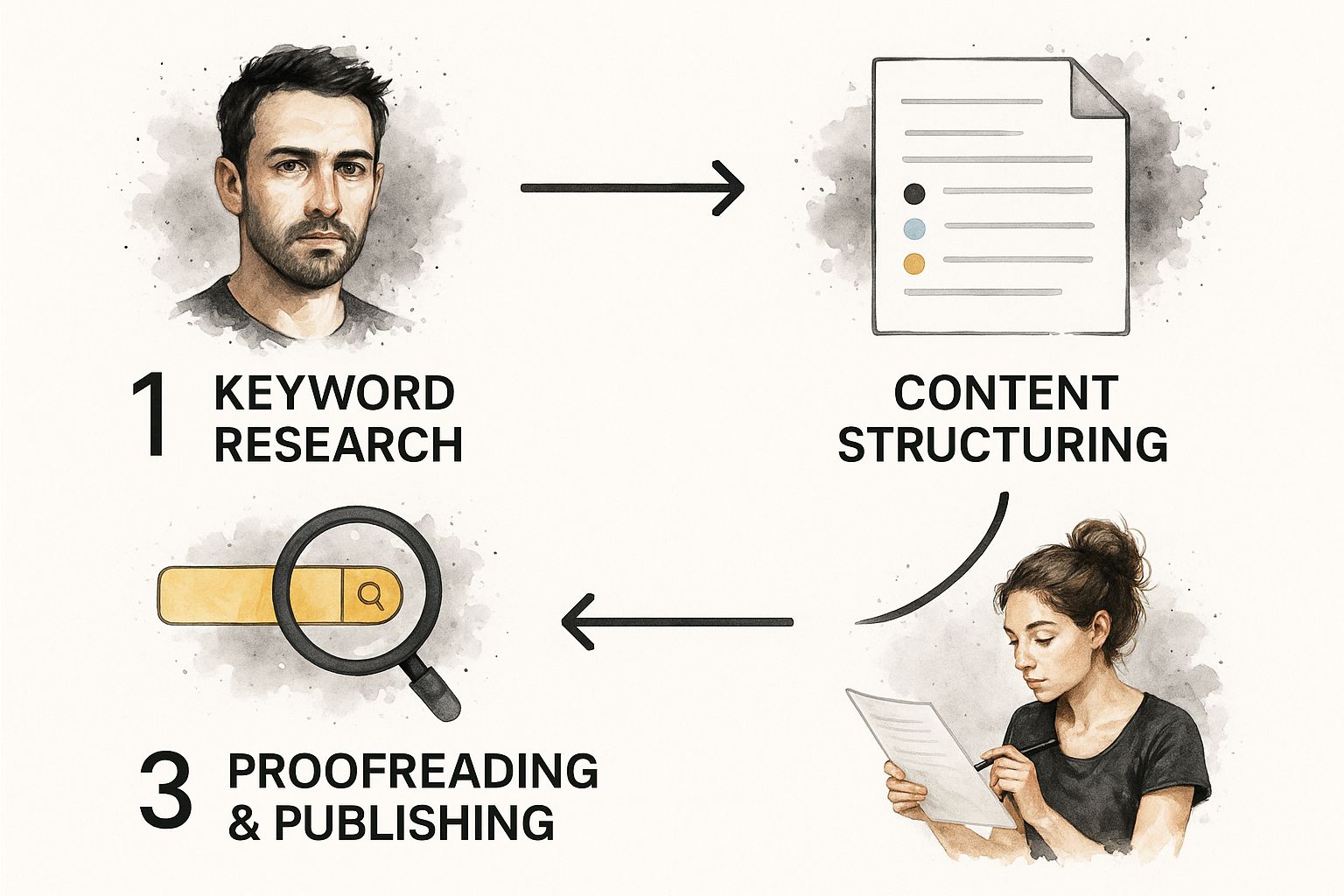Before you even think about writing a single word, you need a plan.
Seriously.
Jumping straight into drafting is like trying to build a house without a blueprint. It might look okay for a minute, but it’s going to be unstable and ultimately fall apart. A solid content foundation ensures every blog post, landing page, and guide you create has a clear purpose and pushes you closer to your business goals.
This isn't just about filling up a page with words; it's about connecting with your readers in a meaningful way.
There's a reason the content marketing industry is exploding. Global revenue is on track to blow past $107 billion by 2026. That’s because businesses know a strong digital presence is non-negotiable. With 73% of B2B and 70% of B2C marketers already all-in on content marketing, a spray-and-pray approach just won't cut it anymore.
Building Your Content Foundation for Success
Define Your Audience and Goals
First things first: get laser-focused on who you're talking to. And I mean really focused. Forget basic demographics for a second and dig into their psychographics.
- What are their biggest headaches and challenges?
- What exact questions are they typing into Google at 2 AM?
- What’s the real motivation that would make them click "buy" or sign up?
Answering these questions helps you craft content that truly resonates. Let’s say you sell project management software. Your audience isn't just "small business owners." They're overwhelmed entrepreneurs drowning in missed deadlines and chaotic team communication. Your content needs to speak directly to that struggle.
Once you know who you're writing for, you have to decide what you want them to do. Every piece of content needs a job. Is it to generate leads? Drive sales? Build your reputation as the go-to expert? A landing page is all about conversion, while a blog post might aim to educate and build trust. This goal will shape your entire approach, from the structure to the final call-to-action.
A strategic plan is what separates content that gets ignored from content that drives real results. For a deeper dive into how this works in practice, check out how smart content marketing for ecommerce can turn readers into loyal customers.
Key Takeaway: Every successful piece of website content starts with two simple questions: "Who am I helping?" and "What do I want them to do next?" Get these right, and you'll write with a purpose that people can feel.
To help you nail this down every time, here’s a simple framework I use before starting any new content project.
Core Content Planning Framework
| Planning Element | Key Question to Answer | Example |
|---|---|---|
| Target Audience | Who am I writing for (in detail)? | Overwhelmed freelance graphic designers struggling to manage client feedback. |
| Audience Pain Point | What specific problem am I solving? | They waste hours tracking revisions in long email chains and need a better system. |
| Content Goal | What action do I want the reader to take? | Sign up for a free trial of our project's visual feedback tool. |
| Primary Keyword | What is their main search query? | "best way to manage client feedback" |
| Content Format | What's the best way to deliver this info? | A detailed "how-to" blog post with screenshots and a template. |
This table isn't just a box-ticking exercise. Answering these questions forces you to think strategically and ensures your content is built on a rock-solid foundation from the very beginning.
Master Foundational Keyword Research
Keyword research isn't about stuffing awkward phrases into your articles. It’s your direct window into your audience's brain. It’s how you discover what they care about, the language they use, and what they're looking for answers to.
You'll want to use SEO tools to find your core topics, but don't forget about long-tail keywords. These are the longer, more specific phrases people use when they're much closer to making a decision. Think "best running shoes for flat feet" versus just "running shoes." The intent is completely different.
This whole process, from research to hitting "publish," is a continuous loop, not a one-and-done task.

As you can see, it all starts with strategic research. Get that right, and you’re well on your way to creating polished content that actually attracts and engages the right people.
Finding Topics Your Audience Craves

Tired of staring at a blank page, guessing what to write about? Here’s a secret: great website content isn't born from a lucky guess. It's uncovered through smart research. If you want to create articles that genuinely connect with people and solve their real-world problems, you need to look beyond basic keyword tools.
The goal isn't just finding keywords with high search volume. The real magic happens when you get inside your audience's head. You need to uncover their specific questions, frustrations, and goals. Before you can write a single word that resonates, you first have to know exactly who you're talking to by creating detailed buyer personas.
Uncover Topics Hiding in Plain Sight
Your audience is constantly telling you what they want to read. You just need to know where to listen. Standard keyword tools are a decent starting point for gauging broad demand, but the richest insights almost always come from raw, unfiltered conversations.
Start by digging into the online communities where your ideal customers actually hang out. Places like Reddit and Quora are absolute goldmines for this. Search for your core topics, but pay very close attention to the language people use.
- What's the phrasing of their questions? Look for the recurring pain points and frustrations that keep popping up.
- Check out the top-voted answers. These show you what solutions the community already finds valuable.
- Pinpoint the knowledge gaps. Are there questions that get asked over and over but never seem to get a truly satisfying answer? That's your content opportunity right there.
For instance, if you sell productivity software, a quick search on a subreddit like r/smallbusiness might reveal a dozen threads from entrepreneurs asking, "How do you handle client scope creep?" Now that's a far more compelling topic than just targeting a generic keyword like "productivity software."
Analyze Your Competitors and Your Customers
Looking at what your competitors are doing is a classic strategy for a reason. Find the top-ranking articles for your target topics and do more than just skim them—dissect their structure. What specific questions do they answer? What are their key talking points? And most importantly, what do they miss? Your best content will often live in that gap.
Pro Tip: Don't just analyze their successes. Hunt down their comment sections. Are readers asking follow-up questions or voicing confusion? Those comments are free content ideas, handed to you on a silver platter.
Finally, look inward. Your own customer service emails, sales call notes, and social media comments are incredibly valuable. These are direct lines to your audience's biggest needs, all expressed in their own words. If you want to see how we put these principles into action to generate fresh ideas, check out the topic examples on the RebelGrowth blog.
By combining these methods, you shift from just "writing content for a website" to crafting valuable resources that your audience is actively searching for. You’ll end up with a list of topics rooted in genuine user needs, setting every single article up for success from the get-go.
Writing Drafts That People Actually Want to Read

You've done the heavy lifting with research and planning. Now for the fun part: turning all those notes, keywords, and outlines into a story that actually connects with someone. This is where the magic happens.
Your first draft is not about perfection. Forget agonizing over every comma or finding the perfect word. Just get your main ideas down on the page. Think of it like a sculptor working with a block of clay—the initial goal is just to get the basic shape down before you start carving out the fine details.
Crafting a Compelling Introduction
You have only a few seconds to grab a reader's attention. That’s it. So, a powerful introduction isn't just nice to have; it's non-negotiable. It needs to hook them fast, show them they're in the right place, and promise a real solution to their problem.
Here are a few battle-tested ways to open strong:
- Ask a relatable question: Kick things off with a question that echoes what your reader is already thinking. Something like, "Struggling to turn website visitors into actual customers?"
- Share a surprising statistic: A jaw-dropping number or a compelling piece of data instantly signals that you've done your homework and your content is worth their time.
- Tell a short story or anecdote: A quick, relevant story makes your content feel more human and memorable. It shows you get it because you've been there yourself.
No matter which path you choose, your intro has one job: convince the reader that sticking around is a good use of their time.
Developing Your Brand Voice and Tone
How you say something is often just as important as what you say. Your brand voice is your company's personality. Are you witty? Authoritative? Super friendly? Formal? Whatever it is, that voice needs to stay consistent across everything you publish.
Your tone, on the other hand, can and should change depending on the topic and who you're talking to. A deep-dive technical guide will naturally have a more serious tone than a lighthearted blog post about your company culture.
The key is to be intentional. Before you start writing, decide on the feeling you want to create and stick with it. This kind of consistency is what builds trust and makes your brand feel authentic.
Writing for a website isn't just about dumping information; it's about building a relationship. Your voice and tone are the main tools you have to shape how people see and connect with your brand.
Making Your Content Scannable and Readable
Let's be real: most people don't read every single word online. They skim. In fact, while a solid 38% of readers will engage with content deeply, a nearly equal 35% are pure skimmers. Your job is to write for both groups.
The best way to do that is to break up those intimidating walls of text. Make your content easy on the eyes with a clear visual flow.
Use these elements to your advantage:
- Short paragraphs: Keep them to 1-3 sentences, max.
- Subheadings: Use clear H2s and H3s to guide readers through the piece.
- Bulleted and numbered lists: These are perfect for making complex info easy to scan and digest.
- Bold text: Make key terms and important takeaways pop.
This isn't just about looking pretty. It's about respecting your reader's time and making your valuable insights accessible. By writing content that’s easy to scan, you’re catering to how people actually read online, which keeps them on your page longer. You can dig deeper into blogging statistics and engagement habits to get a better handle on these trends.
Optimizing Content for Google and Humans

You’ve poured your expertise into a brilliant draft, but what’s the point if no one ever finds it? This is where on-page SEO comes into play. It's not about gaming the system with robotic rules; it's about helping both people and search engines understand what your content is truly about.
Think of it as the bridge between your hard work and the audience that needs it.
The real secret here is to write for people first. Google's gotten incredibly smart over the years, and it rewards content that delivers a great user experience. Stiff, keyword-stuffed text is a relic of the past. The goal now is to weave your keywords into the content so naturally that they just fit.
Weaving Keywords into Your Content
Your primary keyword is the main theme of your article. To send a clear signal to search engines about your topic, it needs to appear in a few key places.
- Your Title (H1): This is the most important spot. Get your main keyword in here, and try to place it near the beginning.
- The First 100 Words: Mentioning your primary keyword early in the introduction immediately confirms the topic for both your readers and Google.
- Headings (H2s & H3s): Sprinkle your primary keyword and related terms into your subheadings. This not only helps with SEO but also structures your content and makes it much easier for skimmers to follow.
- The URL: A clean, keyword-rich URL is another strong signal. Something like
your-site.com/how-to-write-contentworks perfectly.
But don't overdo it. Natural placement is everything. If a phrase feels forced, it probably is. Always prioritize readability.
The Power of Internal and External Linking
Links give your content context and authority. They act as pathways, guiding users to more valuable information and signaling credibility to search engines. It's a win-win.
Internal links are links that point to other pages on your own website. They are incredibly powerful for a few reasons: they help Google discover and index more of your content, they pass authority between your pages, and they keep visitors on your site longer. For instance, after reading this post, you might want to learn how great copy improves conversions on your dedicated landing pages.
External links, on the other hand, point to other reputable websites. Linking out to trusted, authoritative sources shows you’ve done your research. It adds a layer of credibility to your work and demonstrates that you're focused on providing the best possible information for your reader.
Pro Tip: Never just use "click here" as your link text. Go for descriptive anchor text that tells the reader exactly what they'll get when they click, like "learn more about on-page SEO" or "download the content checklist."
Final Touches for Visibility
A few final details can make a surprising difference in how your content performs. These are small steps, but they have a big impact on both user experience and search visibility.
First, always write descriptive alt text for your images. Alt text is what screen readers use to describe an image to visually impaired users, and it also helps Google understand what your images are about.
Next, focus on structure. Well-structured content with short paragraphs, bullet points, and clear headings is more likely to be featured in Google's "featured snippets"—those answer boxes at the top of the search results. Winning a snippet can dramatically boost your visibility.
Finally, remember that optimization is just one piece of the puzzle. To make sure your content truly delivers, you'll want to use a comprehensive conversion optimization checklist to turn that hard-earned traffic into real results.
Polishing and Publishing for Maximum Impact
This is it. The final stretch. This is where good content turns into great content. It’s that last, critical mile where the pros pull away from the amateurs. I know how tempting it is to just hit “publish,” but rushing this final step can undo all the hard work you’ve already put in.
A solid editing and publishing process is what ensures your content makes a powerful first impression and actually does its job. This isn't just about hunting for typos. It's about sharpening your message for clarity, impact, and a flawless reader experience.
Nail Down Your Editing Workflow
Here's the biggest mistake I see people make: they try to edit everything at once. You simply can't check for grammar mistakes while also judging the overall flow and structure. It just doesn't work. The fix is to edit in separate, focused passes.
Start with a self-edit that’s all about the big picture. I always recommend reading your draft out loud. It's a game-changer for catching clunky phrasing and sentences that just don't land right. Ask yourself:
- Does this flow logically from one point to the next?
- Is my main point crystal clear?
- Did I actually deliver on the promise from the intro?
Once you've shored up the structure, it's time to switch hats and do a detailed proofread. This pass is purely about the mechanics—grammar, spelling, and punctuation. A tool like Grammarly can be a huge help here, but don't lean on it as a crutch. It won't catch every contextual error or understand the specific tone you're going for. Nothing beats a final human read-through.
Weave In Compelling Visuals
In an age of infinite scrolling, visuals are what stop people in their tracks. A giant wall of text is a one-way ticket to the "back" button. Images, infographics, and videos break up the page and make your hard-hitting points much easier to digest.
But please, don't just sprinkle in generic stock photos for decoration. Your visuals should support and enhance your message. A sharp infographic can distill a complex process into something simple. A quick video can show someone how to do something way better than a block of text ever could.
If you need help creating these kinds of assets, checking out a digital marketing directory is a good way to find specialized creative talent.
Key Insight: Your content’s visual appeal is just as important as the words on the page. Strategic visuals improve reader engagement, boost comprehension, and increase the likelihood that your content will be shared.
The Final Pre-Publish Checklist
Right before you push that button, run through one last quick check. This is your final quality control scan to make sure everything is optimized for both your readers and the search engines.
- Meta Description: Is it compelling and under 160 characters? Think of this as your sales pitch on the Google results page.
- Alt Text: Have you written descriptive alt text for every single image? It's crucial for both accessibility and SEO.
- Links: Do all your internal and external links work? Make sure they open in a new tab so you don't send people away from your site.
- Call-to-Action (CTA): Is your main CTA clear, easy to spot, and perfectly aligned with the article's goal?
This final once-over is what separates polished, professional content from the rest. It shows you care about the details, which builds credibility. After all, 82% of consumers feel more positive about a brand after reading its custom content. You can see more compelling content writing stats that really drive home how much this stuff matters.
Even with a solid plan, you're bound to run into questions once you start writing for your website. It happens to everyone. Let's tackle a few of the most common ones I hear so you can get back to creating great content with confidence.
How Long Should My Website Content Be?
There’s no magic number here. The real answer is always: as long as it needs to be to cover the topic completely. A tight, punchy landing page might crush its conversion goals at 500 words. A comprehensive guide, on the other hand, could need over 2,000 words to actually be useful to the reader.
Instead of getting hung up on word count, check out the top-ranking pages for your target keyword. Are they short and sweet? Or are they massive, detailed resources? Your job is to make something even better and more thorough than what’s already out there. Let the topic's depth and what your reader needs to know be your guide.
How Often Should I Publish New Content?
Here's the deal: consistency beats frequency, every single time. It's far better to publish one incredible, deeply researched article a month than it is to crank out four shallow posts that don't help anyone. Chasing an unrealistic publishing schedule is a fast track to burnout and mediocre content.
For most businesses, aiming for one to four genuinely well-crafted posts per month is a fantastic, sustainable goal. This pace steadily builds your authority and shows Google your site is active and consistently adding value. Pick a schedule you can actually stick to without ever letting the quality slip.
Key Takeaway: Think of AI as an incredibly smart research assistant, not the author. It's a tool for efficiency, not a replacement for your expertise. Your unique voice, experience, and stories are what will ultimately connect with your audience and build lasting trust.
Can I Use AI to Write My Content?
Absolutely, but you need to be smart about it. AI writing tools like RebelGrowth are brilliant for blasting through writer's block, brainstorming topics, structuring an outline, or finding a better way to phrase a clunky sentence. They can be a seriously powerful partner in the content creation process.
What you shouldn't do is let AI write an entire article from start to finish. The final piece absolutely must be reviewed, edited, and infused with your unique human expertise, brand voice, and personal stories. Content that's 100% AI-generated often feels flat and lacks the authentic spark needed to build a real connection with readers. Use it to work faster, not to replace your thinking.
Ready to stop guessing and start growing? RebelGrowth combines powerful AI tools with strategic marketing insights to help you create content that ranks, engages, and converts. From AI-generated blog posts to a dynamic backlink network, we provide everything you need to boost your website traffic. Take control of your content strategy today at https://rebelgrowth.com.
